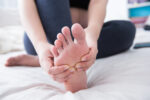Foot surgery eases walking-related pain in CMT: Small study
Procedure did not address slow gait, poor balance

Foot surgery may help reduce pain during walking and correct the way people with Charcot–Marie–Tooth disease (CMT) stand, a brief report by researchers in Italy suggests.
While foot surgery may not address functional limitations like a slow gait and poor balance, it “allows [patients] to wear shoes, and leads to a perceived improvement and satisfaction,” the researchers wrote in “Short-term effects of foot surgery on walking-related pain, function, and satisfaction in patients with Charcot–Marie–Tooth disease: a prospective cohort study,” which appeared in Frontiers in Neurology.
CMT is caused by damage to the nerves that control the muscles and relay sensory information, such as the sense of touch, from the limbs to the brain. As a result, patients have weakness and numbness in their feet, legs, arms, and hands. Because people with CMT may have curled toes and feet that are either highly arched or flat, walking may be difficult. Some may need foot surgery to correct deformities.
“Restoration of foot shape, ankle joint mobility, and loading ability [which starts when the foot contacts the ground and ends when the opposite foot leaves the ground] should result in an improvement in terms of progression, stability, and [walking-related pain],” wrote the researchers who evaluated the short-term effects of foot surgery in five women and five men, ages 25-64. Two had surgery twice. After surgery, all went home with a recommendation to avoid bearing any weight on their feet. They returned for physical rehabilitation a month later.
Results of foot surgery for CMT patients
One month after surgery, pain severity was reduced from a median 5.5 to 2 points. Pain severity was scored on a scale from 0 (no pain) to 10 (the worst imaginable), with a minimal clinically important difference of 2 points. The largest improvements were seen by the most compromised patients.
Three patients had a 3-point increase in pain severity, “due to an ill-suited fit of the pre-surgical orthosis with the current leg and foot anatomy,” the researchers wrote. An orthosis is a device, such as a splint, that’s fitted to a body part to improve function.
Ankle range of motion also improved. Also, the center of pressure progression (COPP) during walking, a measure of the way the feet touch the ground, improved from 44% to 60%, indicating better foot posture.
In the first month after surgery, both the ankle’s range of motion and foot posture improved, “supporting the idea of potential improvements in other variables in the months to come,” the researchers wrote.
Surgery did fail to improve other aspects of walking, such as gait speed, balance, and lower limb function.
The Patient Global Impression of Change, which ranges from 1 (much improved) to 7 (much worsened) was used to assess the patients’ perception of change after surgery. They reported having “improved” or “much improved” after surgery.
“When asked about the reasoning behind this assessment, most of them answered that they felt better because either the [walking-related pain] subsided or they could use off-the-rack shoes after surgery,” wrote the researchers, who noted their findings came from a small sample of 10 patients. This means more research with longer follow-ups is needed to confirm the effects of foot surgery on walking-related pain, foot posture, and patient satisfaction.







